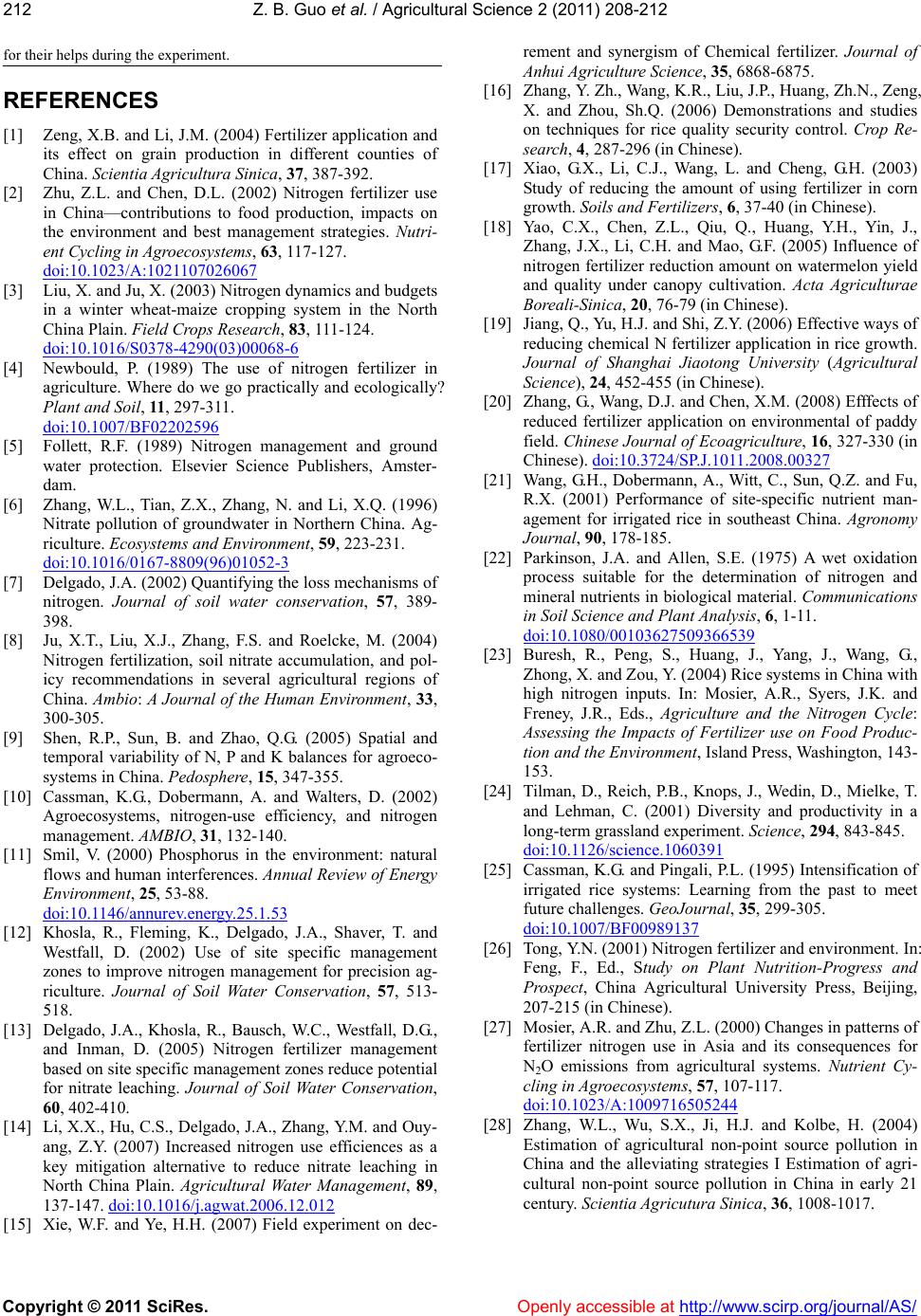
Z. B. Guo et al. / Agricultural Science 2 (2011) 208-212
Copyright © 2011 SciRes. http://www.scirp.org/journal/AS/
212
for their helps during the experiment.
Openly accessible at
REFERENCES
[1] Zeng, X.B. and Li, J.M. (2004) Fertilizer application and
its effect on grain production in different counties of
China. Scientia Agr icultura Sinica, 37, 387-392.
[2] Zhu, Z.L. and Chen, D.L. (2002) Nitrogen fertilizer use
in China—contributions to food production, impacts on
the environment and best management strategies. Nutri-
ent Cycling in Agroecosystems, 63, 117-127.
doi:10.1023/A:1021107026067
[3] Liu, X. and Ju, X. (2003) Nitrogen dynamics and budgets
in a winter wheat-maize cropping system in the North
China Plain. Field Crops Research, 83, 111-124.
doi:10.1016/S0378-4290(03)00068-6
[4] Newbould, P. (1989) The use of nitrogen fertilizer in
agriculture. Where do we go practically and ecologically?
Plant and Soil, 11, 297-311.
doi:10.1007/BF02202596
[5] Follett, R.F. (1989) Nitrogen management and ground
water protection. Elsevier Science Publishers, Amster-
dam.
[6] Zhang, W.L., Tian, Z.X., Zhang, N. and Li, X.Q. (1996)
Nitrate pollution of groundwater in Northern China. Ag-
riculture. Ecosystems and Environment, 59, 223-231.
doi:10.1016/0167-8809(96)01052-3
[7] Delgado, J.A. (2002) Quantifying the loss mechanisms of
nitrogen. Journal of soil water conservation, 57, 389-
398.
[8] Ju, X.T., Liu, X.J., Zhang, F.S. and Roelcke, M. (2004)
Nitrogen fertilization, soil nitrate accumulation, and pol-
icy recommendations in several agricultural regions of
China. Ambio: A Journal of the Human Environment, 33,
300-305.
[9] Shen, R.P., Sun, B. and Zhao, Q.G. (2005) Spatial and
temporal variability of N, P and K balances for agroeco-
systems in China. Pedosphere, 15, 347-355.
[10] Cassman, K.G., Dobermann, A. and Walters, D. (2002)
Agroecosystems, nitrogen-use efficiency, and nitrogen
management. AMBIO, 31, 132-140.
[11] Smil, V. (2000) Phosphorus in the environment: natural
flows and human interferences. Annual Review of Energy
Environment, 25, 53-88.
doi:10.1146/annurev.energy.25.1.53
[12] Khosla, R., Fleming, K., Delgado, J.A., Shaver, T. and
Westfall, D. (2002) Use of site specific management
zones to improve nitrogen management for precision ag-
riculture. Journal of Soil Water Conservation, 57, 513-
518.
[13] Delgado, J.A., Khosla, R., Bausch, W.C., Westfall, D.G.,
and Inman, D. (2005) Nitrogen fertilizer management
based on site specific management zones reduce potential
for nitrate leaching. Journal of Soil Water Conservation,
60, 402-410.
[14] Li, X.X., Hu, C.S., Delgado, J.A., Zhang, Y.M. and Ouy-
ang, Z.Y. (2007) Increased nitrogen use efficiences as a
key mitigation alternative to reduce nitrate leaching in
North China Plain. Agricultural Water Management, 89,
137-147. doi:10.1016/j.agwat.2006.12.012
[15] Xie, W.F. and Ye, H.H. (2007) Field experiment on dec-
rement and synergism of Chemical fertilizer. Journal of
Anhui Agriculture Science, 35, 6868-6875.
[16] Zhang, Y. Zh., Wang, K.R., Liu, J.P., Huang, Zh.N., Zeng,
X. and Zhou, Sh.Q. (2006) Demonstrations and studies
on techniques for rice quality security control. Crop Re-
search, 4, 287-296 (in Chinese).
[17] Xiao, G.X., Li, C.J., Wang, L. and Cheng, G.H. (2003)
Study of reducing the amount of using fertilizer in corn
growth. Soils and Fertilizers, 6, 37-40 (in Chinese).
[18] Yao, C.X., Chen, Z.L., Qiu, Q., Huang, Y.H., Yin, J.,
Zhang, J.X., Li, C.H. and Mao, G.F. (2005) Influence of
nitrogen fertilizer reduction amount on watermelon yield
and quality under canopy cultivation. Acta Agriculturae
Boreali-Sinica, 20, 76-79 (in Chinese).
[19] Jiang, Q., Yu, H.J. and Shi, Z.Y. (2006) Effective ways of
reducing chemical N fertilizer application in rice growth.
Journal of Shanghai Jiaotong University (Agricultural
Science), 24, 452-455 (in Chinese).
[20] Zhang, G., Wang, D.J. and Chen, X.M. (2008) Efffects of
reduced fertilizer application on environmental of paddy
field. Chinese Journal of Ecoagriculture, 16, 327-330 (in
Chinese). doi:10.3724/SP.J.1011.2008.00327
[21] Wang, G.H., Dobermann, A., Witt, C., Sun, Q.Z. and Fu,
R.X. (2001) Performance of site-specific nutrient man-
agement for irrigated rice in southeast China. Agronomy
Journal, 90, 178-185.
[22] Parkinson, J.A. and Allen, S.E. (1975) A wet oxidation
process suitable for the determination of nitrogen and
mineral nutrients in biological material. Communications
in Soil Science and Plant Analysis, 6, 1-11.
doi:10.1080/00103627509366539
[23] Buresh, R., Peng, S., Huang, J., Yang, J., Wang, G.,
Zhong, X. and Zou, Y. (2004) Rice systems in China with
high nitrogen inputs. In: Mosier, A.R., Syers, J.K. and
Freney, J.R., Eds., Agriculture and the Nitrogen Cycle:
Assessing the Impacts of Fertilizer use on Food Produc-
tion and the Environment, Island Press, Washington, 143-
153.
[24] Tilman, D., Reich, P.B., Knops, J., Wedin, D., Mielke, T.
and Lehman, C. (2001) Diversity and productivity in a
long-term grassland experiment. Science, 294, 843-845.
doi:10.1126/science.1060391
[25] Cassman, K.G. and Pingali, P.L. (1995) Intensification of
irrigated rice systems: Learning from the past to meet
future challenges. GeoJournal, 35, 299-305.
doi:10.1007/BF00989137
[26] Tong, Y.N. (2001) Nitrogen fertilizer and environment. In:
Feng, F., Ed., Study on Plant Nutrition-Progress and
Prospect, China Agricultural University Press, Beijing,
207-215 (in Chinese).
[27] Mosier, A.R. and Zhu, Z.L. (2000) Changes in patterns of
fertilizer nitrogen use in Asia and its consequences for
N2O emissions from agricultural systems. Nutrient Cy-
cling in Agroecosystems, 57, 107-117.
doi:10.1023/A:1009716505244
[28] Zhang, W.L., Wu, S.X., Ji, H.J. and Kolbe, H. (2004)
Estimation of agricultural non-point source pollution in
China and the alleviating strategies I Estimation of agri-
cultural non-point source pollution in China in early 21
century. Scientia Agricu tura Sinica, 36, 1008-1017.